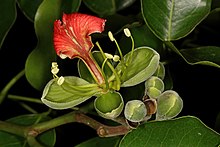Afzelia quanzensis (pod mahogany, Afrikaans: peulmahonie, Venda: mutokota, Zulu: inkehli) is a species of tree native to sub-Saharan Africa.[2] It ranges from Somalia and Democratic Republic of the Congo to South Africa.[1] It is a protected tree in South Africa.[2]
| Pod mahogany | |
|---|---|

| |

| |
| A. quanzensis in the Kruger Park, and the irregular flower (below) | |
| Scientific classification | |
| Kingdom: | Plantae |
| Clade: | Tracheophytes |
| Clade: | Angiosperms |
| Clade: | Eudicots |
| Clade: | Rosids |
| Order: | Fabales |
| Family: | Fabaceae |
| Genus: | Afzelia |
| Species: | A. quanzensis
|
| Binomial name | |
| Afzelia quanzensis Welw. (1859)
| |
| Synonyms[1] | |
| |
Description edit
This deciduous tree can grow up to 20m in height, and has smooth, grey bark, which can flake in irregular patches. It has glossy dark green leaves and blooms between October and November. The flowers have one large red petal. After flowering, it produces a seed capsule, a thick wood-like pod, which contains black seeds with a hard, bright red aril covering one end.[3]
Uses edit
The seeds are sometimes made into native necklaces and the timber is an ornamental and lumber hardwood, used in furniture, parquet flooring and railway sleepers.[3]
This plant may be used in traditional medicine.[4]
See also edit
References edit
- ^ a b Afzelia quanzensis Welw. Plants of the World Online. Retrieved 17 October 2023.
- ^ a b "Protected Trees" (PDF). Department of Water Affairs and Forestry, Republic of South Africa. 3 May 2013. Archived from the original (PDF) on 5 July 2010.
- ^ a b Drummond, R.B., ed. (1972). The Bundu Book of Trees, Flowers and Grasses (2nd ed.). Salisbury, Rhodesia: Longman Rhodesia. p. 19. ISBN 058257532X.
- ^ Cumes, David (2009). Healing trees & plants of the Lowveld. Rael Loon, Dries Bester. Cape Town, South Africa: Struik Nature. ISBN 978-1-77007-833-8. OCLC 506229195.
External links edit
- Dressler, S.; Schmidt, M. & Zizka, G. (2014). "Afzelia quanzensis". African plants – a Photo Guide. Frankfurt/Main: Forschungsinstitut Senckenberg.